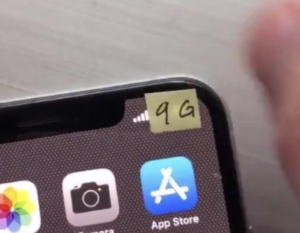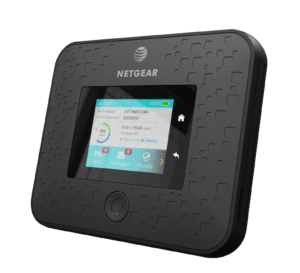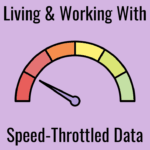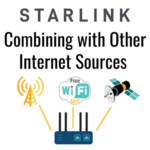UPDATE (2/5/2019): Apple Embracing 5GE Label in iOS 12.2

As we reported in December (original story below), several Android phones have been updated to display "5GE" over the past several weeks, and it appears as if Apple customers will soon be getting an "upgrade" to 5G on AT&T too.
Over the past few days some AT&T customers running the latest beta version of iOS 12.2 on iPhone XS and the latest iPad Pro models have noticed an AT&T 5GE icon in the status bar, and today AT&T confirmed to Ars Technica that this is intentional:
"Some iPhone and iPad users could start seeing our 5G Evolution indicator on their devices. The indicator simply helps customers know when they are in an area where the 5G Evolution experience may be available."
AT&T says it has over 400 markets where "5G Evolution" technologies including 4x4 MIMO, 256 QAM, and three-way carrier aggregation are deployed - upping average cellular speeds to over 40Mbps.
But despite the "5GE" name - these are NOT 5G technologies, and the same LTE-Advanced technologies are being used by Verizon, T-Mobile, and Sprint in many areas of the country without any special (and arguably misleading) icons in the status bar.
Apple will be releasing iOS 12.2 in the next few weeks to the world - but do not be fooled, you are not getting any sort of real upgrade other than an icon.
AT&T has also just posted an updated on its real 5G technology rollout - saying that it is not planning nationwide Mobile 5G Coverage until early 2020, though 5GE should go nationwide in the Spring of 2019.
Our original story continues below.

Today (December 21st, 2018) is AT&T's official launch date for the first mobile 5G network in America.
But though that launch is limited to just a single compatible device available for free to "select" customers in tiny parts of just twelve cities, AT&T today revealed plans to get "5G" onto potentially millions of existing devices across the nation, as if by magic.
AT&T gave the details in a statement today to Fierce Wireless:
“If they have one of the latest Android devices and it connects to a tower that’s enabled with 5G Evolution, they’ll soon see a “5G E” indicator pop up on their screen. Initially we’ll roll this out on a handful of devices, with more devices showing the indicator in spring 2019.”
Wow - a free upgrade to 5G!
Except AT&T's "5G Evolution" has nothing to do with real fifth generation cellular technology.
In reality this is just marketing smoke and mirrors.
"5G Evolution" has been a thing for over a year now, and it is what AT&T has been calling cell towers and devices that have support for the latest 4G/LTE technologies such as 256QAM, 4x4 MIMO, and multi-band carrier aggregation.
In other words - the same technologies that ever other company in the industry calls "4G/LTE".
So what on earth is going on here?
Busy?
Just want a quick wrap-up?
For the video version of this story:
Like Video? Subscribe to our YouTube Channel
Deja Vu: AT&T "4G" All Over Again

If this sounds familiar - it is because we've been down this confusing road before.
Way back during the dawn of the 4G era, Verizon had a substantial head start in rolling out true fourth generation LTE technology.
But AT&T (and T-Mobile) had invested in pushing their 3G networks to the performance limit with a technology called HSPA+, and in practice HSPA+ actually often rivaled the performance of Verizon's first generation LTE devices.
So to avoid being dismissed as being a generation out of date just because of the label on the phone's status bar, AT&T and T-Mobile both began calling their 3G HSPA+ networks "4G", and their true fourth generation networks "4G/LTE".
Even Apple eventually caved in and began using this 4G label for AT&T and T-Mobile, and we've been stuck explaining the difference between fake "4G" and real 4G/LTE ever since.
AT&T's Future: "5GE" vs "5G+"

The situation is a bit different this time around however.
AT&T's true fifth generation network deployment is initially focused on using extremely high frequency millimeter wave cellular spectrum that allows for potentially amazing speeds and massive improvements in network capacity, but it also has extremely limited range.
AT&T has decided to call this mmWave coverage "5G+".
So outside of congested urban cores, and even indoors or inside vehicles - many future AT&T 5G devices will be spending much of their time falling back to 4G/LTE.
Or rather - now they will just see "5GE", a potentially less jarring shift for people who might have just paid a premium for a shiny new 5G device.
And AT&T will be able to sell 5GE and 5G+ devices side-by-side, and only those who follow cellular technology closely will even know that only the 5G+ capable devices are actually truly 5G.
T-Mobile’s “5G For All”

While AT&T and Verizon are pushing to bring 5G to market first, and are focusing initially on using 5G to add urban capacity, T-Mobile is instead pursuing a "5G For All" strategy by using its low-frequency long-range 600MHz spectrum to try and jump ahead in building a nationwide 5G network.
Low frequency spectrum doesn't have the same raw speed potential as mmWave, but it should still offer improvements over existing LTE capabilities - and significantly improved lower latencies.
T-Mobile has released an entertaining smackdown of the other carriers 5G strategies, saying:
"Verizon and AT&T’s 5G strategy is limited … and sloooow to bring us real 5G … and will light up 5G to only a few places in the short term. But pressure from New T-Mobile’s broad and deep nationwide 5G will require them to do more, and do it faster, to compete."
T-Mobile's goal is nationwide coverage, using the pooled spectrum resources it will gain assuming its merger with Sprint goes through:
"If approved, New T-Mobile will have the spectrum assets to bring 5G to everyone, everywhere, including rural areas. By 2021, New T-Mobile’s network will cover almost 2/3 of the US population with speeds of 100+Mbps, and that increases to almost 90% by 2024."
And indeed - this competitive race is just beginning, and things will only really start to get interesting around this time next year.
Right now the state of the 5G world is mostly just smack talk, early trials, and a lot of boasting about the future.
So... Is 5GE Silly, or Smart?
 From the technologist's perspective, calling any fourth generation cellular technology "5G" is ridiculous and confusing.
From the technologist's perspective, calling any fourth generation cellular technology "5G" is ridiculous and confusing.
But from a consumer's perspective - if your phone says "5GE" you are probably on a device and in range of a tower that will give you pretty impressive speeds, especially compared to classic LTE areas that have not yet been fully upgraded.
Do you really care what is going on under the hood?
Just like LTE, 5G cellular technology will evolve over the next decade - enabling an entirely new world of performance and capabilities.
And eventually the carriers' strategies will converge - with all the carriers using both low-frequencies for extended range (like T-Mobile) and mmWave for capacity and speed (like Verizon and AT&T).
The technology strategies will converge that is.
Their marketing and product naming strategies around 5G on the other hand are likely to remain confusing forever - or at least until 6GE++ comes out.








 Mobile Internet Resource Center (dba Two Steps Beyond LLC) is founded by Chris & Cherie of
Mobile Internet Resource Center (dba Two Steps Beyond LLC) is founded by Chris & Cherie of